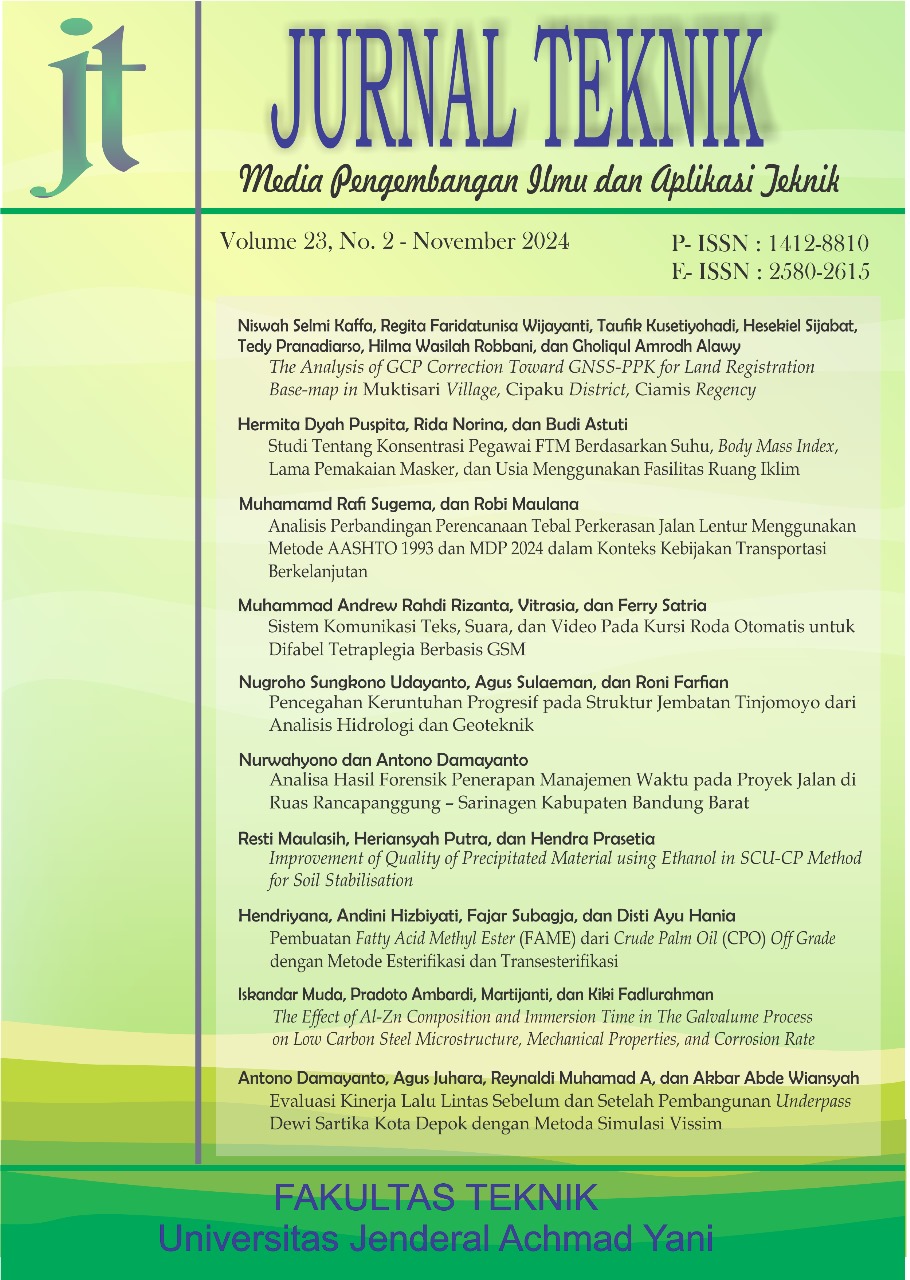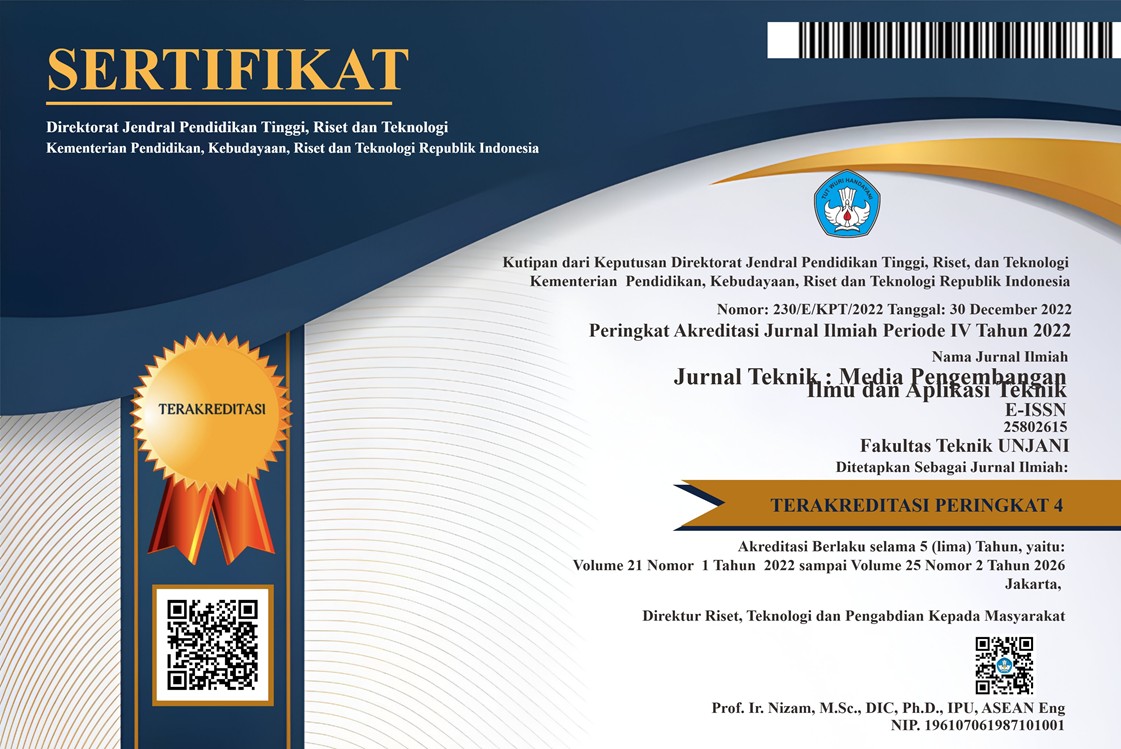Analisa Hasil Forensik Penerapan Manajemen Waktu pada Proyek Jalan Di Ruas Rancapanggung – Sarinagen Kabupaten Bandung Barat
DOI:
https://doi.org/10.55893/jt.vol23no2.651Keywords:
Importance Index, Influence Index, Frequency Index, Time Management , Construction ProjectAbstract
Time management is a crucial process to ensure projects are completed on time, which focuses on planning and scheduling project activities to make them faster and more efficient. This research explores the application of time management in the Road construction project in Rancapanggung - Sarinagen, West Bandung Regency, implemented by PT Basuki - Lesindo, KSO. The purpose of this study is to identify and understand the factors that hinder time management and the dominant factors that influence it. The research method used a quantitative approach through questionnaires to 21 respondents, followed by descriptive analysis and ranking of respondents, and validation through interviews. The results showed four main barriers in the implementation of time management, insufficient number of work tools (dominant factor with 44.5%), inappropriate construction methods (43%), lack of communication and coordination among the project implementation team (41.5%), and materials that are damaged or not according to specifications (41.4%). The most dominant factor in the delay was the insufficient number of work tools, indicating the importance of adequate resource allocation.
References
Amoatey, C. T. (2017). Exploring critical road project delay factors in Ghana. Journal of Facilities Management, 15(2), 110-127.
ARITEKIN, A. R. (2024). Analisis Faktor-Faktor Pekerjaan Proyek Prasarana Jalan Lingkungan. Konstruksi: Publikasi Ilmu Teknik, Perencanaan Tata Ruang dan Teknik Sipil, 38-54.
Bhatt, N. &. (2020). Evaluation of success and risk factors for highway project performance through integrated analytical hierarchy process and fuzzy interpretive structural modelling. International Journal of Construction Management, 20(6), 65.
Deep, S. B. (2022). Critical factors influencing the performance of highway projects: an empirical evaluation. Buildings, 12(6), 849.
Ghozali, I. (2018). Aplikasi Analisis Multivariate SPSS 25. Semarang: Universitas Diponegoro.
Gómez-Cabrera, A. S.-B.-D.-T. (2020). Identification of factors affecting the performance of rural road projects in Colombia. Sustainability, 12(18), 7377.
Leo-olagbaye, F. &. (2018). An evaluation of risk factors and their impact on road project. Journal of Construction Business and Management, 2(2), 24-35.
Ojha, R. &. (2017). Integrated impact of highway infrastructure, labour productivity and circular material consumption on Indian manufacturing growth: A system dynamics perspective. Journal of Advances in Management Research, 14(4), 527-542.
PUPR, P. M. (2016). Indonesia Paten No. No. 28/PRT/M/2016.
Rizal, A. H., Manek, P. K., & Bella, R. A. (2023). ANALISIS FAKTOR-FAKTOR PENYEBAB PERBEDAAN WAKTU ANTARA PERENCANAAN DAN REALISASI DI LAPANGAN PADA PROYEK KONSTRUKSI. Jurnal Teknik Sipil, 12 No. 2, 159-172.
Sugiyono. (2017). Metode Penelitian Kuantitatif, Kualitatif, dan R&D. Alfabeta.
Additional Files
Published
Issue
Section
License
Copyright (c) 2025 Nurwahyono, Antono Damayanto

This work is licensed under a Creative Commons Attribution-NonCommercial-ShareAlike 4.0 International License.
Penulis yang menyerahkan artikel di Jurnal Teknik: Media Pengembangan dan Aplikasi Teknik untuk keperluan publikasi telah mengetahui bahwa Jurnal Teknik: Media Pengembangan dan Aplikasi Teknik memberikan akses terbuka terhadap konten untuk mendukung pertukaran informasi mengenai ilmu pengetahuan, sesuai dengan penerbitan daring yang berbasis Open Access Journal dan mengikuti Creative Commons Attribution 4.0 International License. Sehingga penulis setuju dengan ketentuan-ketentuan berikut:
1. Penulis memegang hak cipta dan memberikan hak publikasi pertama kepada pihak jurnal dengan pekerjaan secara bersamaan
di bawah Creative Commons Attribution 4.0 International License yang memungkinkan orang lain untuk berbagi pekerjaan
dengan pengakuan kepengarangan karya dan publikasi pertama artikel tersebut di Jurnal Teknik: Media Pengembangan dan
Aplikasi Teknik.
2. Penulis dapat melakukan perjanjian tambahan untuk hak distribusi non-eksklusif artikel yang telah diterbitkan di jurnal ini
(misalnya, posting ke sebuah repositori institusi atau menerbitkannya dalam sebuah buku), dengan mengakui bahwa
publikasi pertama dilakukan di Jurnal Teknik: Media Pengembangan dan Aplikasi Teknik.
3. Penulis diizinkan dan didorong untuk menyebarkan karya mereka secara daring (misalnya, dalam repositori institusi atau
laman web penulis) setelah artikel terbit (proses penerbitan artikel selesai). Hal ini terkait dengan imbas dari pertukaran
informasi yang produktif (Lihat Pengaruh Open Access).












